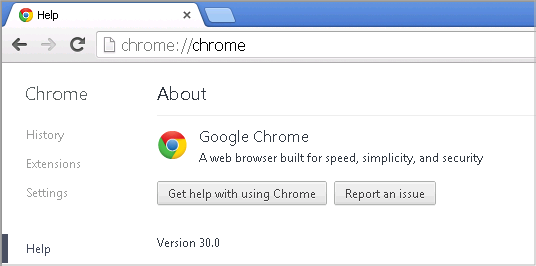Yesterday Google Chrome team released the stable version of Chrome 30 on Windows, Mac and Linux. We just deployed Chrome 30 to all our OS platforms and it's now available to all our paying customers and free users.

Try Chrome 30 in Browserling now!
Significant changes in Chrome 30:
- New image context menu item: "Search Google for this image".
- New Chrome Apps APIs: webview.request, media gallery write support and downloads.
- New platform features (both in desktop and mobile): Support for the WebRTC Device Enumeration API, allowing users to change their microphones and/or camera on the fly without having to restart the WebRTC call. DevTools now supports CSS source maps. Chrome will now match the behavior of IE and not honor the Refresh header or tags when the URL to be refreshed to has a
javascript:scheme.
Significant changes in Android version of Chrome 30:
- New gesture: swipe horizontally across the top toolbar to quickly switch tabs.
- New gesture: drag vertically down from the toolbar to enter into the tab switcher view.
- New gesture: drag down from the menu to open the menu and select wanted item without having to lift finger.
- WebGL is enabled by default on high-end devices.
- DeviceMotion (device acceleration and rotation rates) events.
- Media Source Extension is enabled on Android 4.1+.
- Two new experimental features behind a flag: Web Speech API (recognition) and the Vibration API.
Significant changes in iOS version of Chrome 30:
- New look and feature enhancements for iOS7.
- Improvements to Fullscreen behavior especially on iPad (iOS7 only).
- New Settings UI.
- Maps and email links launch the Google Maps and Gmail apps (if installed) automatically. You can change your preference in Settings.
- Stability / security improvements and bug fixes.
Chrome 30 implements the following new features and updates:
- DOM3 mouseenter & mouseleave Events - MouseEvents dispatched when a pointing device is moved onto or off of an Element or one of its descendents. Similar to mouseover and mouseout respectively, but are not cancelable and are not dispatched more than one "round-trip" into an Element's boundary.
- imageSmoothingEnabled attribute for CanvasRenderingContext2D - The CanvasRenderingContext2D.imageSmoothingEnabled attribute can be set to change if images are smoothed. It is true by default. On getting the imageSmoothingEnabled property, the last value it was set to, is returned.
The new Chrome 30 release also includes 50 security fixes. The following fixescontributed by external researchers were highlighted by Chrome team:
- CVE-2013-2906: Races in Web Audio. Credit to Atte Kettunen of OUSPG.
- CVE-2013-2907: Out of bounds read in Window.prototype object. Credit to Boris Zbarsky.
- CVE-2013-2908: Address bar spoofing related to the 204 No Content status code. Credit to Chamal de Silva.
- CVE-2013-2909: Use after free in inline-block rendering. Credit to Atte Kettunen of OUSPG.
- CVE-2013-2910: Use-after-free in Web Audio. Credit to Byoungyoung Lee of Georgia Tech Information Security Center (GTISC).
- CVE-2013-2911: Use-after-free in XSLT. Credit to Atte Kettunen of OUSPG.
- CVE-2013-2912: Use-after-free in PPAPI. Credit to Chamal de Silva and 41.w4r10r(at)garage4hackers.com.
- CVE-2013-2913: Use-after-free in XML document parsing. Credit to cloudfuzzer.
- CVE-2013-2914: Use after free in the Windows color chooser dialog. Credit to Khalil Zhani.
- CVE-2013-2915: Address bar spoofing via a malformed scheme. Credit to Wander Groeneveld.
- CVE-2013-2916: Address bar spoofing related to the 204 No Content status code. Credit to Masato Kinugawa.
- CVE-2013-2917: Out of bounds read in Web Audio. Credit to Byoungyoung Lee and Tielei Wang of Georgia Tech Information Security Center (GTISC).
- CVE-2013-2918: Use-after-free in DOM. Credit to Byoungyoung Lee of Georgia Tech Information Security Center (GTISC).
- CVE-2013-2919: Memory corruption in V8. Credit to Adam Haile of Concrete Data.
- CVE-2013-2920: Out of bounds read in URL parsing. Credit to Atte Kettunen of OUSPG.
- CVE-2013-2921: Use-after-free in resource loader. Credit to Byoungyoung Lee and Tielei Wang of Georgia Tech Information Security Center (GTISC).
- CVE-2013-2922: Use-after-free in template element. Credit to Jon Butler.
- CVE-2013-2923: Various fixes from internal audits, fuzzing and other initiatives (Chrome 30).
- CVE-2013-2924: Use-after-free in ICU.
Happy cross-browser testing in Chrome 30!
Email this blog post to your friends or yourself!
Try Browserling!
Enter a URL to test, choose platform, browser and version, and you'll get a live interactive browser in 5 seconds!



 Subscribe to updates!
Subscribe to updates!
 BizSpark
BizSpark